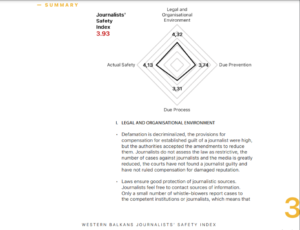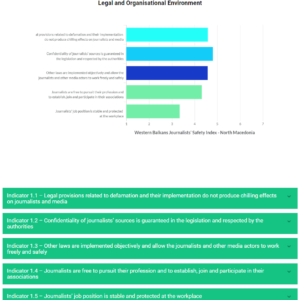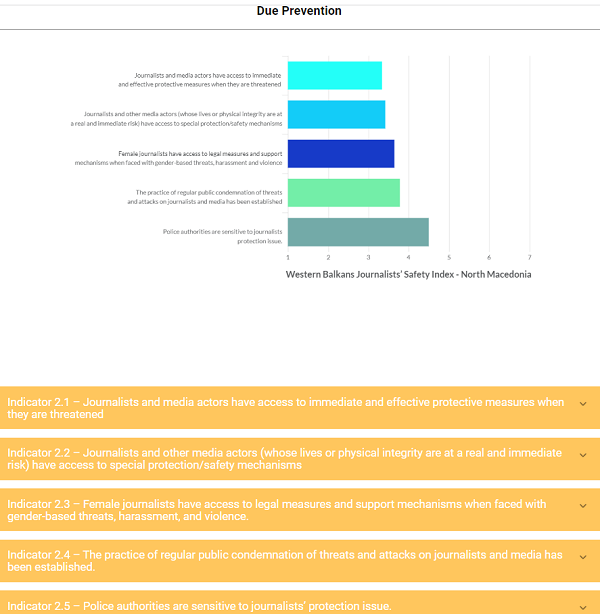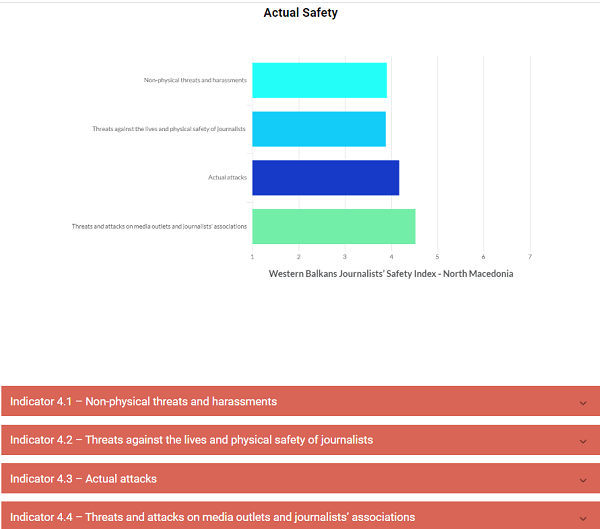PETRIT SARACINI
Journalists and media workers in North Macedonia are the safest compared to other countries in the Western Balkans. According to the Western Balkans Journalists’ Safety Index for 2020 of the Western Balkans Journalists’ Association Platform „Safejournalists.net“, of the 7 countries included in the research, North Macedonia has an average score of 3.93, which ranks the country better than the other countries of the Western Balkans in the Index.
The Index measures the situation in this part through indicators for four areas that assess the legal and organizational environment, due prevention, due processing and actual safety.

The Index for our country is published on the website of the Platform, and in the report of the Index for North Macedonia for 2020, which is published on the website of the Association of Journalists of Macedonia, and indicates specifically the areas where there is improvement, as well as those where weaknesses have been noted.
Legal environment: Smaller fines and less cases against journalists, there are no attempts to silence journalists but sources are afraid, worker’s rights under attack
In the part legal and organizational environment, the Report concludes that although defamation is decriminalized, the provisions for compensation for established guilt of a journalist were high, but the authorities accepted the amendments to reduce them. Journalists do not assess the law as restrictive, the number of cases against journalists and the media is greatly reduced, the courts have not found a journalist guilty and have not ruled compensation for damaged reputation
According to the Index, the laws ensure good protection of journalistic sources. Journalists feel free to contact sources of information. But on the other hand, only a small number of whistle-blowers report cases to the competent institutions or journalists, which means that there is still an atmosphere of fear among the sources.

Indicators for legal and organizational environment, source: safejournalists.net
Although in the country there is no legal protection from the so-called unfounded lawsuits, there are no such cases, or examples of arbitrary or discriminatory application of other laws in order to restrict the freedom of journalistic work.
“No attempts were made to silence journalists, based on the arbitrary application of legal provisions related to the dissemination of misinformation, fear or panic, although there were examples of dissemination of misinformation during the pandemic”, is said in the narrative report on North Macedonia.
The Index further notes that the journalistic profession is not subject to licensing, but the Law on Media still contains a restrictive definition of the term journalist. “During the pandemic there were cases when some journalists were prevented from asking questions”, is said in the Report.
The Index notes more serious challenges in relation to trade union organization and labor relations. Although most journalists are organized in professional associations, there is some pressure on union members from media owners or managers of the private media to avoid calculating union membership fees from journalists’ salaries, which causes them to lose their union status. Many journalists in the private media mainly have fixed-term or part-time contracts.
“The difficult socio-economic situation of journalists was further aggravated by the pandemic, as several media outlets cut the salaries of journalists and media workers. A small number of private media have trade unions, i.e., journalists are still afraid or lack interest for organizing themselves within the media in which they work”, is said in the report of the Index for North Macedonia.
Prevention is failing, except for the Cybercrime Sector at the Ministry of Interior, journalists have no one to turn to
In the section for due prevention, the report says that the established telephone line for fast and efficient assistance to journalists in case of attacks did not work. “The journalists who were the subject of attacks had nowhere to turn to the institutions for immediate assistance and support, except for the Cybercrime Sector at the Ministry of Interior. Out of the registered online attacks (14 in total) on journalists, only two were prosecuted”, is written in the report.
Although in the legislation there are general provisions according to which journalists could seek protection in case of a serious threat to their life from a known person, it is not enough clear how practical such a procedure is. “There is a procedure in the law, but the risk assessment procedure is not clearly defined”, is concluded in the Report.

Indicators for due prevention, source: safejournalists.net
According to the Index, in 2020, a mechanism for free legal aid for any victim of gender-based assault and violence, including woman journalists, was not yet established.
“All attacks on women journalists were reported to the Ministry of Interior. Journalists in newsrooms rarely report cases of gender-based discrimination to the competent institutions. The Istanbul Convention was incorporated in the legislation adopted in the beginning of 2021. The practice indicates that there were a lot of gender-based threats and harassment towards female journalists”, is written in the Report for North Macedonia.
The Report concludes that there is an established practice of public condemnation of attacks on journalists, but that there are also examples of politicians and public officials insulting and threatening journalists and the media, thus creating an “environment for insecurity and fear among journalists”.
On the other hand, the Report points out that cooperation of the AJM with the MoI is regular, and the attitude of the police towards journalists is satisfactory. “The MoI conducts regular trainings for police officers, within which they are introduced to the basic standards for respect for human rights. The MoI and AJM have established regular cooperation. During 2020, the attitude of police officers towards journalists and media workers was at a satisfactory level”, is written in the Report.
Inefficient investigations, only two charges for online attacks, criticism for the prosecution, judiciary and police
Most remarks in the Report for North Macedonia are in the section due process. They refer to the inefficiency and non-transparency of the investigations on the attacks, pointing out that the investigations are generally slow and inefficient and that no charges have been filed against individual attacks against journalists.
“There are no special departments or specially designated persons in the competent institutions to conduct investigations on the attacks on journalists. No specific guidelines have been adopted that can help conduct investigations more efficiently. There is cooperation between the competent institutions, but it does not result in sufficient efficiency in identifying the perpetrators of the attacks. The public prosecutors are quite inert in initiating procedures”, is said in the Report.
In the Report it is pointed out that attacks on journalists are sometimes not qualified as crimes, because of which journalists are forced to file private lawsuits instead of charges being filed ex officio.

Indicators for due process, source: safejournalists.net
The Criminal Code recognizes harassment as a criminal offence, and 8 serious online threats against journalists have been registered, but according to the report, the MoI did not react effectively enough and did not provide any information on how it acted in five of the six reported cases of online attacks on journalists in 2020.
Remarks are also addressed to the judiciary. According to the research, the general assessment is that “the courts are not transparent enough in terms of conducting court proceedings for attacks on journalists or the media”.
The Report further indicates that the Basic Civil and Criminal Court in Skopje does not provide detailed information on court proceedings for attacks on journalists that have occurred in recent years, whereas courts do not have the practice of informing the public about proceedings against journalists or in which journalists are parties due to violation of their rights in the direction of breached security.
“Additionally, the automatic case management information system (ACMIS) does not provide the opportunity for precise search for past and current procedures in which the parties are journalists and thus the public has more difficulty accessing this information”, is concluded in the Report that also points out that the competent institutions and courts have not established quality statistical systems, based on which they can submit accurate and fragmented data on all court proceedings in which journalists or the media are parties, because the databases of the courts do not allow disaggregation of the data.
Actual safety: Three threats and two physical attacks on journalists, attackers are usually officials or persons close to political parties
According to the Index, only some of the listed types of threats in 2020 do not have the aim to endanger the physical safety of journalists, whereas attackers were former officials, individuals close to political parties and (in one case) police officers.
“Three threats were registered in 2020, aimed at endangering the physical safety or life of journalists. However, it is worrying that the attackers are politicians or individuals close to political parties. Two physical attacks on journalists were registered in 2020. In both cases, there are indications that the attackers are individuals close to political parties. Two cases of threats against the media were registered. In both cases, the threats against the media are due to their investigative work on corruption cases or critical public statements”, is said in the Report for North Macedonia of the Western Balkans Journalists’ Safety Index.
Indicators for Actual Safety, source: safejournalists.net
***
The Index relies on research data for several different areas linked to “safety of journalists”, which are developed in the form of indicators and are collected and analyzed by the partners in the Platform based on rigorous research procedure developed by the RESIS Institute from Skopje, with the purpose to measure through numbers the changes in the seven countries of the Western Balkans for the last year. The reference values in the Index are assessed from 1 (worst) to 7 (the best), in four areas:
- Legal and organizational environment – the existence and implementation of legal safeguards relevant for the safety of journalists;
- Due Prevention – the existence and implementation of a range of preventative measures that have direct effects on journalists’ protection and safety;
- Due Process – the behavior of state institutions and public officials towards journalists and the efficiency of the criminal and civil justice system concerning the investigations of threats and acts of violence against journalists;
- Actual Safety – incidents and instances of various forms of threats and acts of violence against journalists and media.
In the following years, the improvement or deterioration of the situation in all countries will be measured by taking into account the assessment for 2020 as a reference year, is said in the Report.

